Managing Information and Technology
VerifiedAdded on 2023/01/13
|11
|3871
|46
AI Summary
This document explores the concepts of managing information and technology in the context of Thames Water, a private organisation responsible for water supply and waste water treatment in the UK. It discusses Porter's 5 Force Analysis and Porter's Value Chain to understand the competitive environment and internal activities of the company.
Contribute Materials
Your contribution can guide someone’s learning journey. Share your
documents today.
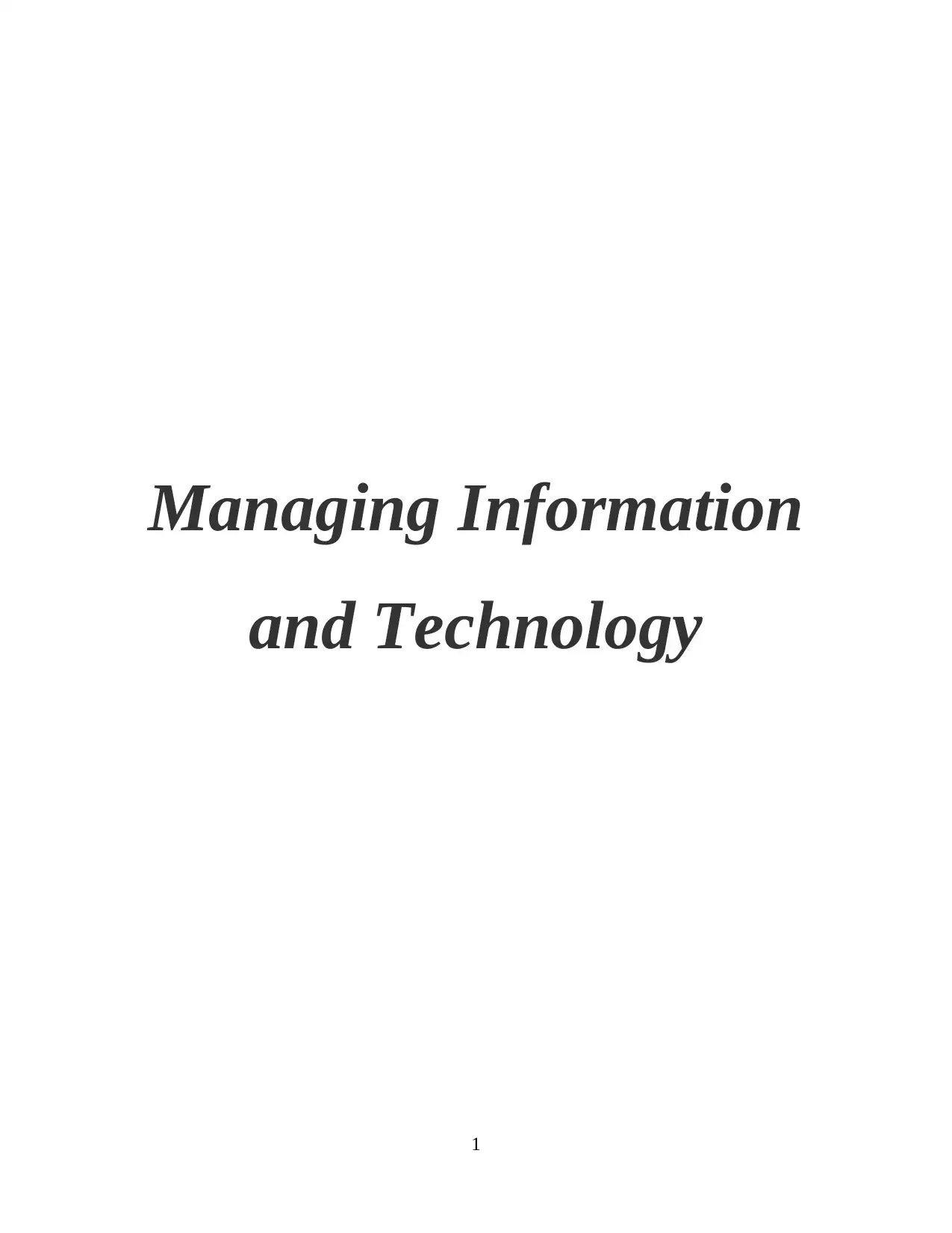
Managing Information
and Technology
1
and Technology
1
Secure Best Marks with AI Grader
Need help grading? Try our AI Grader for instant feedback on your assignments.
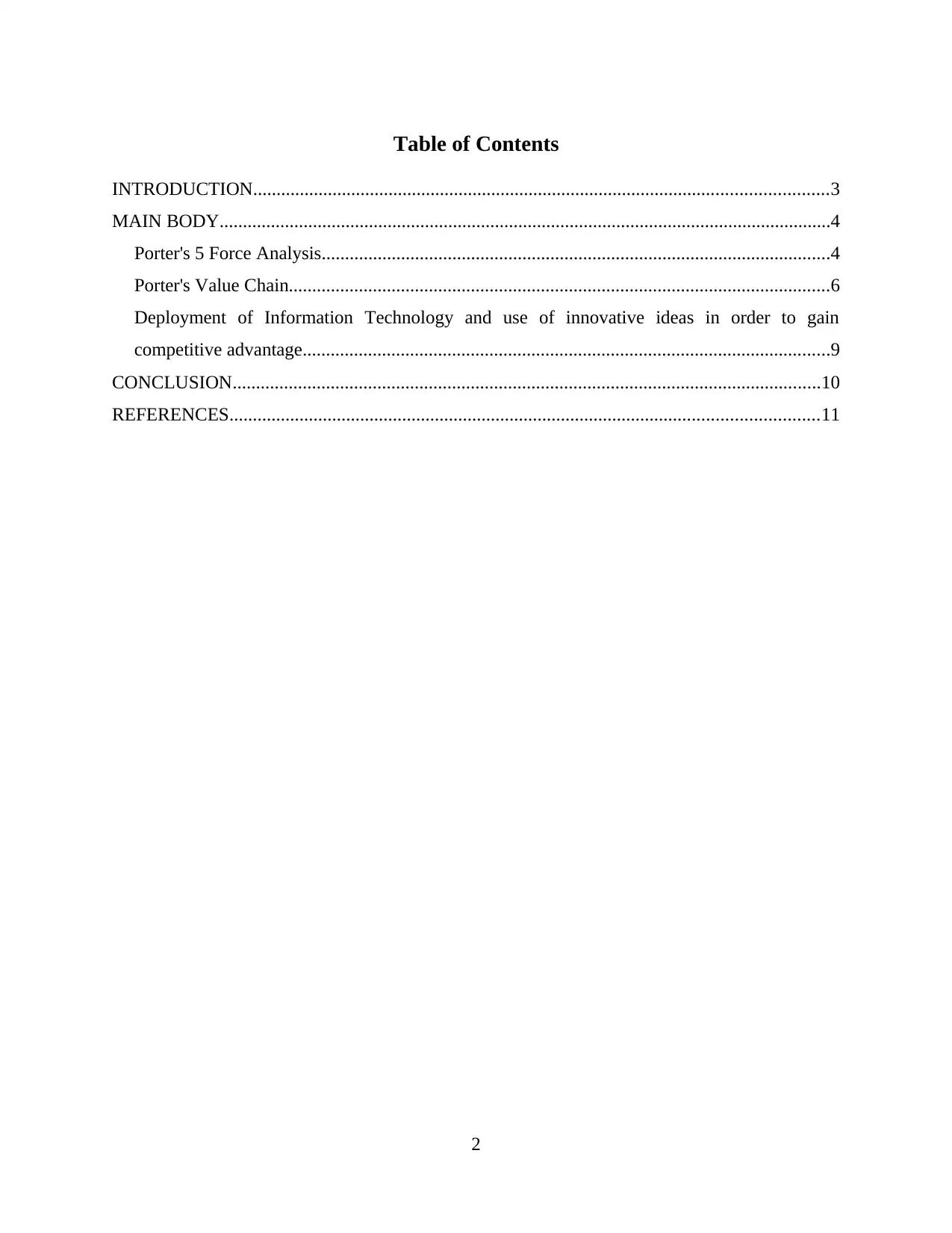
Table of Contents
INTRODUCTION...........................................................................................................................3
MAIN BODY...................................................................................................................................4
Porter's 5 Force Analysis.............................................................................................................4
Porter's Value Chain....................................................................................................................6
Deployment of Information Technology and use of innovative ideas in order to gain
competitive advantage.................................................................................................................9
CONCLUSION..............................................................................................................................10
REFERENCES..............................................................................................................................11
2
INTRODUCTION...........................................................................................................................3
MAIN BODY...................................................................................................................................4
Porter's 5 Force Analysis.............................................................................................................4
Porter's Value Chain....................................................................................................................6
Deployment of Information Technology and use of innovative ideas in order to gain
competitive advantage.................................................................................................................9
CONCLUSION..............................................................................................................................10
REFERENCES..............................................................................................................................11
2
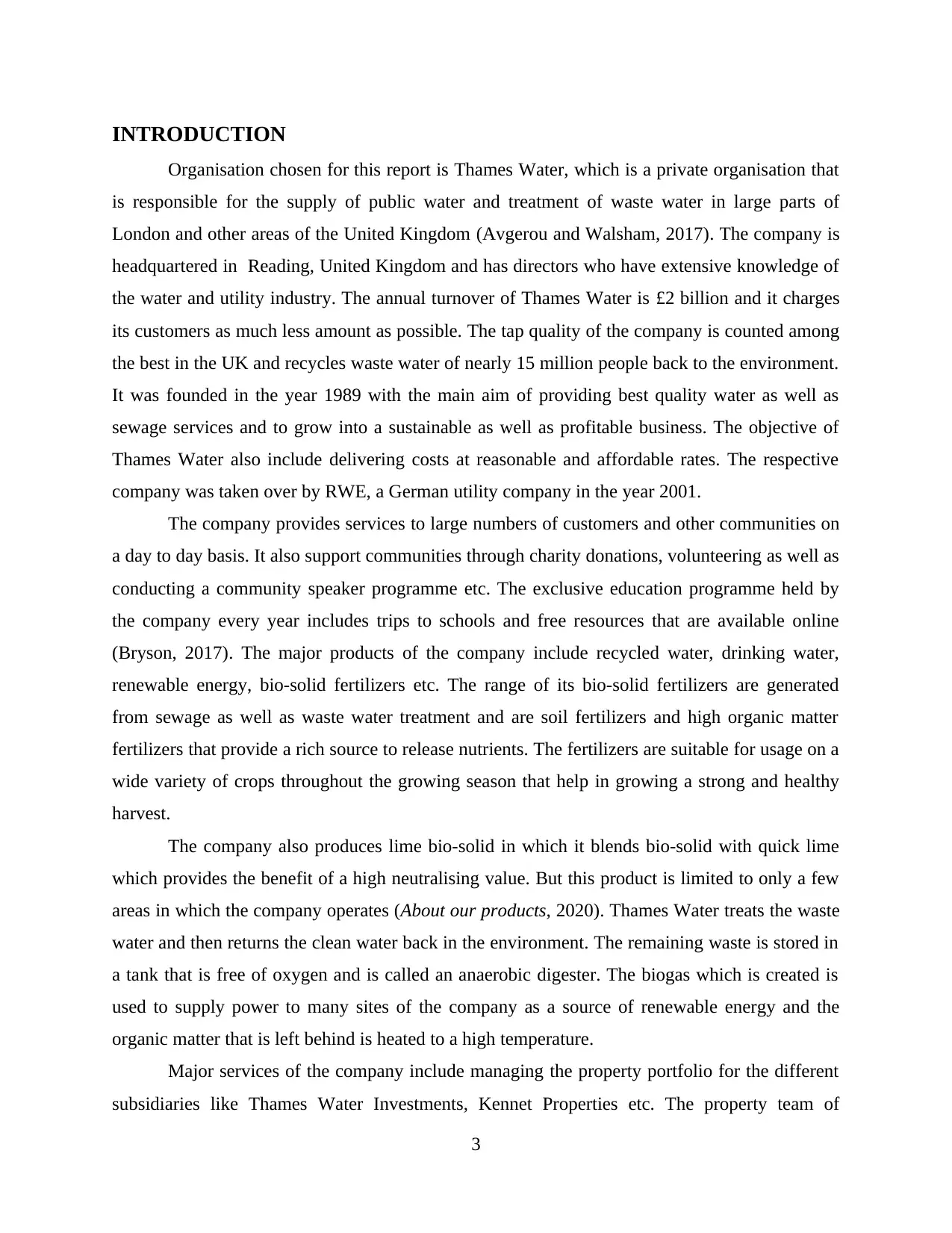
INTRODUCTION
Organisation chosen for this report is Thames Water, which is a private organisation that
is responsible for the supply of public water and treatment of waste water in large parts of
London and other areas of the United Kingdom (Avgerou and Walsham, 2017). The company is
headquartered in Reading, United Kingdom and has directors who have extensive knowledge of
the water and utility industry. The annual turnover of Thames Water is £2 billion and it charges
its customers as much less amount as possible. The tap quality of the company is counted among
the best in the UK and recycles waste water of nearly 15 million people back to the environment.
It was founded in the year 1989 with the main aim of providing best quality water as well as
sewage services and to grow into a sustainable as well as profitable business. The objective of
Thames Water also include delivering costs at reasonable and affordable rates. The respective
company was taken over by RWE, a German utility company in the year 2001.
The company provides services to large numbers of customers and other communities on
a day to day basis. It also support communities through charity donations, volunteering as well as
conducting a community speaker programme etc. The exclusive education programme held by
the company every year includes trips to schools and free resources that are available online
(Bryson, 2017). The major products of the company include recycled water, drinking water,
renewable energy, bio-solid fertilizers etc. The range of its bio-solid fertilizers are generated
from sewage as well as waste water treatment and are soil fertilizers and high organic matter
fertilizers that provide a rich source to release nutrients. The fertilizers are suitable for usage on a
wide variety of crops throughout the growing season that help in growing a strong and healthy
harvest.
The company also produces lime bio-solid in which it blends bio-solid with quick lime
which provides the benefit of a high neutralising value. But this product is limited to only a few
areas in which the company operates (About our products, 2020). Thames Water treats the waste
water and then returns the clean water back in the environment. The remaining waste is stored in
a tank that is free of oxygen and is called an anaerobic digester. The biogas which is created is
used to supply power to many sites of the company as a source of renewable energy and the
organic matter that is left behind is heated to a high temperature.
Major services of the company include managing the property portfolio for the different
subsidiaries like Thames Water Investments, Kennet Properties etc. The property team of
3
Organisation chosen for this report is Thames Water, which is a private organisation that
is responsible for the supply of public water and treatment of waste water in large parts of
London and other areas of the United Kingdom (Avgerou and Walsham, 2017). The company is
headquartered in Reading, United Kingdom and has directors who have extensive knowledge of
the water and utility industry. The annual turnover of Thames Water is £2 billion and it charges
its customers as much less amount as possible. The tap quality of the company is counted among
the best in the UK and recycles waste water of nearly 15 million people back to the environment.
It was founded in the year 1989 with the main aim of providing best quality water as well as
sewage services and to grow into a sustainable as well as profitable business. The objective of
Thames Water also include delivering costs at reasonable and affordable rates. The respective
company was taken over by RWE, a German utility company in the year 2001.
The company provides services to large numbers of customers and other communities on
a day to day basis. It also support communities through charity donations, volunteering as well as
conducting a community speaker programme etc. The exclusive education programme held by
the company every year includes trips to schools and free resources that are available online
(Bryson, 2017). The major products of the company include recycled water, drinking water,
renewable energy, bio-solid fertilizers etc. The range of its bio-solid fertilizers are generated
from sewage as well as waste water treatment and are soil fertilizers and high organic matter
fertilizers that provide a rich source to release nutrients. The fertilizers are suitable for usage on a
wide variety of crops throughout the growing season that help in growing a strong and healthy
harvest.
The company also produces lime bio-solid in which it blends bio-solid with quick lime
which provides the benefit of a high neutralising value. But this product is limited to only a few
areas in which the company operates (About our products, 2020). Thames Water treats the waste
water and then returns the clean water back in the environment. The remaining waste is stored in
a tank that is free of oxygen and is called an anaerobic digester. The biogas which is created is
used to supply power to many sites of the company as a source of renewable energy and the
organic matter that is left behind is heated to a high temperature.
Major services of the company include managing the property portfolio for the different
subsidiaries like Thames Water Investments, Kennet Properties etc. The property team of
3
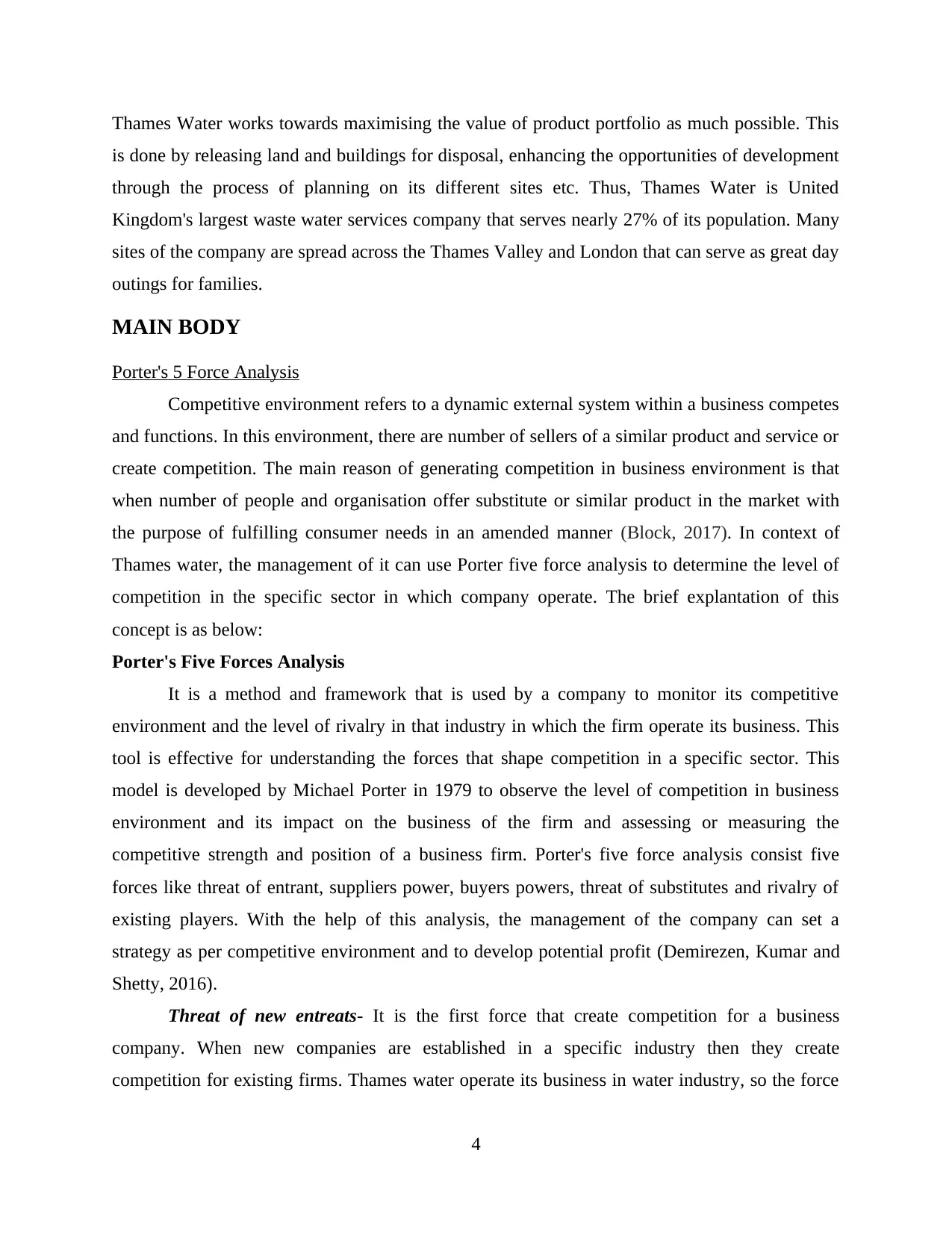
Thames Water works towards maximising the value of product portfolio as much possible. This
is done by releasing land and buildings for disposal, enhancing the opportunities of development
through the process of planning on its different sites etc. Thus, Thames Water is United
Kingdom's largest waste water services company that serves nearly 27% of its population. Many
sites of the company are spread across the Thames Valley and London that can serve as great day
outings for families.
MAIN BODY
Porter's 5 Force Analysis
Competitive environment refers to a dynamic external system within a business competes
and functions. In this environment, there are number of sellers of a similar product and service or
create competition. The main reason of generating competition in business environment is that
when number of people and organisation offer substitute or similar product in the market with
the purpose of fulfilling consumer needs in an amended manner (Block, 2017). In context of
Thames water, the management of it can use Porter five force analysis to determine the level of
competition in the specific sector in which company operate. The brief explantation of this
concept is as below:
Porter's Five Forces Analysis
It is a method and framework that is used by a company to monitor its competitive
environment and the level of rivalry in that industry in which the firm operate its business. This
tool is effective for understanding the forces that shape competition in a specific sector. This
model is developed by Michael Porter in 1979 to observe the level of competition in business
environment and its impact on the business of the firm and assessing or measuring the
competitive strength and position of a business firm. Porter's five force analysis consist five
forces like threat of entrant, suppliers power, buyers powers, threat of substitutes and rivalry of
existing players. With the help of this analysis, the management of the company can set a
strategy as per competitive environment and to develop potential profit (Demirezen, Kumar and
Shetty, 2016).
Threat of new entreats- It is the first force that create competition for a business
company. When new companies are established in a specific industry then they create
competition for existing firms. Thames water operate its business in water industry, so the force
4
is done by releasing land and buildings for disposal, enhancing the opportunities of development
through the process of planning on its different sites etc. Thus, Thames Water is United
Kingdom's largest waste water services company that serves nearly 27% of its population. Many
sites of the company are spread across the Thames Valley and London that can serve as great day
outings for families.
MAIN BODY
Porter's 5 Force Analysis
Competitive environment refers to a dynamic external system within a business competes
and functions. In this environment, there are number of sellers of a similar product and service or
create competition. The main reason of generating competition in business environment is that
when number of people and organisation offer substitute or similar product in the market with
the purpose of fulfilling consumer needs in an amended manner (Block, 2017). In context of
Thames water, the management of it can use Porter five force analysis to determine the level of
competition in the specific sector in which company operate. The brief explantation of this
concept is as below:
Porter's Five Forces Analysis
It is a method and framework that is used by a company to monitor its competitive
environment and the level of rivalry in that industry in which the firm operate its business. This
tool is effective for understanding the forces that shape competition in a specific sector. This
model is developed by Michael Porter in 1979 to observe the level of competition in business
environment and its impact on the business of the firm and assessing or measuring the
competitive strength and position of a business firm. Porter's five force analysis consist five
forces like threat of entrant, suppliers power, buyers powers, threat of substitutes and rivalry of
existing players. With the help of this analysis, the management of the company can set a
strategy as per competitive environment and to develop potential profit (Demirezen, Kumar and
Shetty, 2016).
Threat of new entreats- It is the first force that create competition for a business
company. When new companies are established in a specific industry then they create
competition for existing firms. Thames water operate its business in water industry, so the force
4
Secure Best Marks with AI Grader
Need help grading? Try our AI Grader for instant feedback on your assignments.
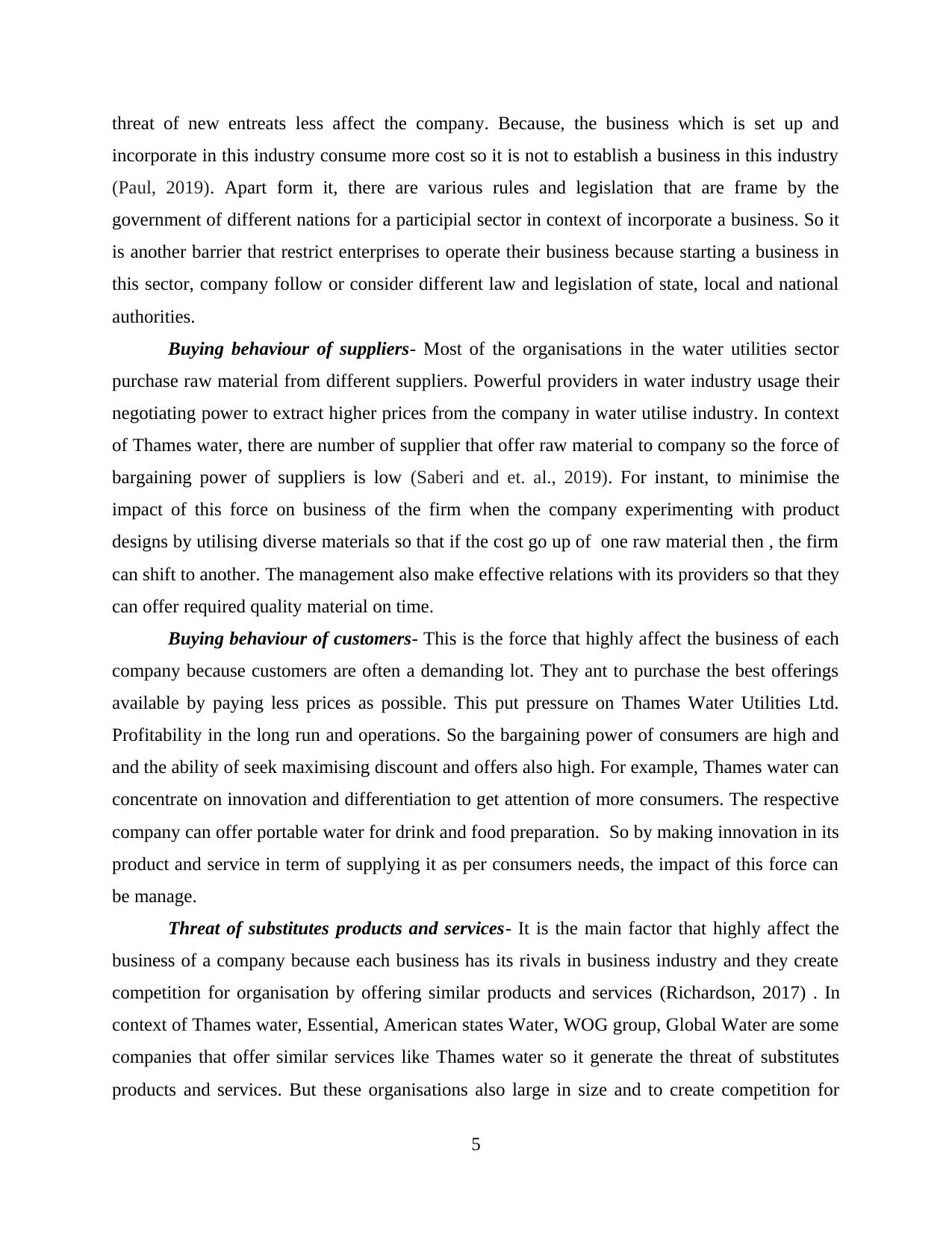
threat of new entreats less affect the company. Because, the business which is set up and
incorporate in this industry consume more cost so it is not to establish a business in this industry
(Paul, 2019). Apart form it, there are various rules and legislation that are frame by the
government of different nations for a participial sector in context of incorporate a business. So it
is another barrier that restrict enterprises to operate their business because starting a business in
this sector, company follow or consider different law and legislation of state, local and national
authorities.
Buying behaviour of suppliers- Most of the organisations in the water utilities sector
purchase raw material from different suppliers. Powerful providers in water industry usage their
negotiating power to extract higher prices from the company in water utilise industry. In context
of Thames water, there are number of supplier that offer raw material to company so the force of
bargaining power of suppliers is low (Saberi and et. al., 2019). For instant, to minimise the
impact of this force on business of the firm when the company experimenting with product
designs by utilising diverse materials so that if the cost go up of one raw material then , the firm
can shift to another. The management also make effective relations with its providers so that they
can offer required quality material on time.
Buying behaviour of customers- This is the force that highly affect the business of each
company because customers are often a demanding lot. They ant to purchase the best offerings
available by paying less prices as possible. This put pressure on Thames Water Utilities Ltd.
Profitability in the long run and operations. So the bargaining power of consumers are high and
and the ability of seek maximising discount and offers also high. For example, Thames water can
concentrate on innovation and differentiation to get attention of more consumers. The respective
company can offer portable water for drink and food preparation. So by making innovation in its
product and service in term of supplying it as per consumers needs, the impact of this force can
be manage.
Threat of substitutes products and services- It is the main factor that highly affect the
business of a company because each business has its rivals in business industry and they create
competition for organisation by offering similar products and services (Richardson, 2017) . In
context of Thames water, Essential, American states Water, WOG group, Global Water are some
companies that offer similar services like Thames water so it generate the threat of substitutes
products and services. But these organisations also large in size and to create competition for
5
incorporate in this industry consume more cost so it is not to establish a business in this industry
(Paul, 2019). Apart form it, there are various rules and legislation that are frame by the
government of different nations for a participial sector in context of incorporate a business. So it
is another barrier that restrict enterprises to operate their business because starting a business in
this sector, company follow or consider different law and legislation of state, local and national
authorities.
Buying behaviour of suppliers- Most of the organisations in the water utilities sector
purchase raw material from different suppliers. Powerful providers in water industry usage their
negotiating power to extract higher prices from the company in water utilise industry. In context
of Thames water, there are number of supplier that offer raw material to company so the force of
bargaining power of suppliers is low (Saberi and et. al., 2019). For instant, to minimise the
impact of this force on business of the firm when the company experimenting with product
designs by utilising diverse materials so that if the cost go up of one raw material then , the firm
can shift to another. The management also make effective relations with its providers so that they
can offer required quality material on time.
Buying behaviour of customers- This is the force that highly affect the business of each
company because customers are often a demanding lot. They ant to purchase the best offerings
available by paying less prices as possible. This put pressure on Thames Water Utilities Ltd.
Profitability in the long run and operations. So the bargaining power of consumers are high and
and the ability of seek maximising discount and offers also high. For example, Thames water can
concentrate on innovation and differentiation to get attention of more consumers. The respective
company can offer portable water for drink and food preparation. So by making innovation in its
product and service in term of supplying it as per consumers needs, the impact of this force can
be manage.
Threat of substitutes products and services- It is the main factor that highly affect the
business of a company because each business has its rivals in business industry and they create
competition for organisation by offering similar products and services (Richardson, 2017) . In
context of Thames water, Essential, American states Water, WOG group, Global Water are some
companies that offer similar services like Thames water so it generate the threat of substitutes
products and services. But these organisations also large in size and to create competition for
5
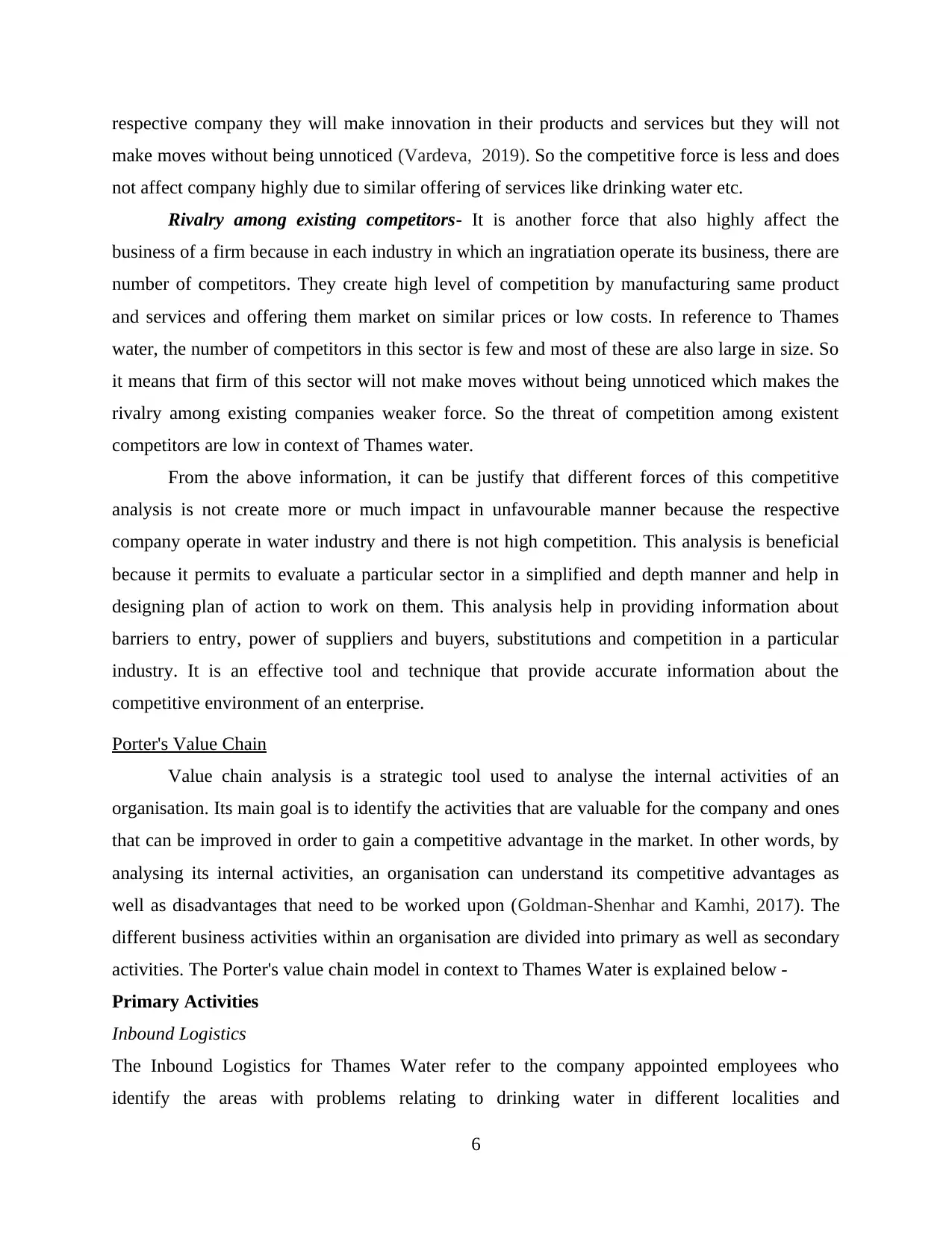
respective company they will make innovation in their products and services but they will not
make moves without being unnoticed (Vardeva, 2019). So the competitive force is less and does
not affect company highly due to similar offering of services like drinking water etc.
Rivalry among existing competitors- It is another force that also highly affect the
business of a firm because in each industry in which an ingratiation operate its business, there are
number of competitors. They create high level of competition by manufacturing same product
and services and offering them market on similar prices or low costs. In reference to Thames
water, the number of competitors in this sector is few and most of these are also large in size. So
it means that firm of this sector will not make moves without being unnoticed which makes the
rivalry among existing companies weaker force. So the threat of competition among existent
competitors are low in context of Thames water.
From the above information, it can be justify that different forces of this competitive
analysis is not create more or much impact in unfavourable manner because the respective
company operate in water industry and there is not high competition. This analysis is beneficial
because it permits to evaluate a particular sector in a simplified and depth manner and help in
designing plan of action to work on them. This analysis help in providing information about
barriers to entry, power of suppliers and buyers, substitutions and competition in a particular
industry. It is an effective tool and technique that provide accurate information about the
competitive environment of an enterprise.
Porter's Value Chain
Value chain analysis is a strategic tool used to analyse the internal activities of an
organisation. Its main goal is to identify the activities that are valuable for the company and ones
that can be improved in order to gain a competitive advantage in the market. In other words, by
analysing its internal activities, an organisation can understand its competitive advantages as
well as disadvantages that need to be worked upon (Goldman-Shenhar and Kamhi, 2017). The
different business activities within an organisation are divided into primary as well as secondary
activities. The Porter's value chain model in context to Thames Water is explained below -
Primary Activities
Inbound Logistics
The Inbound Logistics for Thames Water refer to the company appointed employees who
identify the areas with problems relating to drinking water in different localities and
6
make moves without being unnoticed (Vardeva, 2019). So the competitive force is less and does
not affect company highly due to similar offering of services like drinking water etc.
Rivalry among existing competitors- It is another force that also highly affect the
business of a firm because in each industry in which an ingratiation operate its business, there are
number of competitors. They create high level of competition by manufacturing same product
and services and offering them market on similar prices or low costs. In reference to Thames
water, the number of competitors in this sector is few and most of these are also large in size. So
it means that firm of this sector will not make moves without being unnoticed which makes the
rivalry among existing companies weaker force. So the threat of competition among existent
competitors are low in context of Thames water.
From the above information, it can be justify that different forces of this competitive
analysis is not create more or much impact in unfavourable manner because the respective
company operate in water industry and there is not high competition. This analysis is beneficial
because it permits to evaluate a particular sector in a simplified and depth manner and help in
designing plan of action to work on them. This analysis help in providing information about
barriers to entry, power of suppliers and buyers, substitutions and competition in a particular
industry. It is an effective tool and technique that provide accurate information about the
competitive environment of an enterprise.
Porter's Value Chain
Value chain analysis is a strategic tool used to analyse the internal activities of an
organisation. Its main goal is to identify the activities that are valuable for the company and ones
that can be improved in order to gain a competitive advantage in the market. In other words, by
analysing its internal activities, an organisation can understand its competitive advantages as
well as disadvantages that need to be worked upon (Goldman-Shenhar and Kamhi, 2017). The
different business activities within an organisation are divided into primary as well as secondary
activities. The Porter's value chain model in context to Thames Water is explained below -
Primary Activities
Inbound Logistics
The Inbound Logistics for Thames Water refer to the company appointed employees who
identify the areas with problems relating to drinking water in different localities and
6
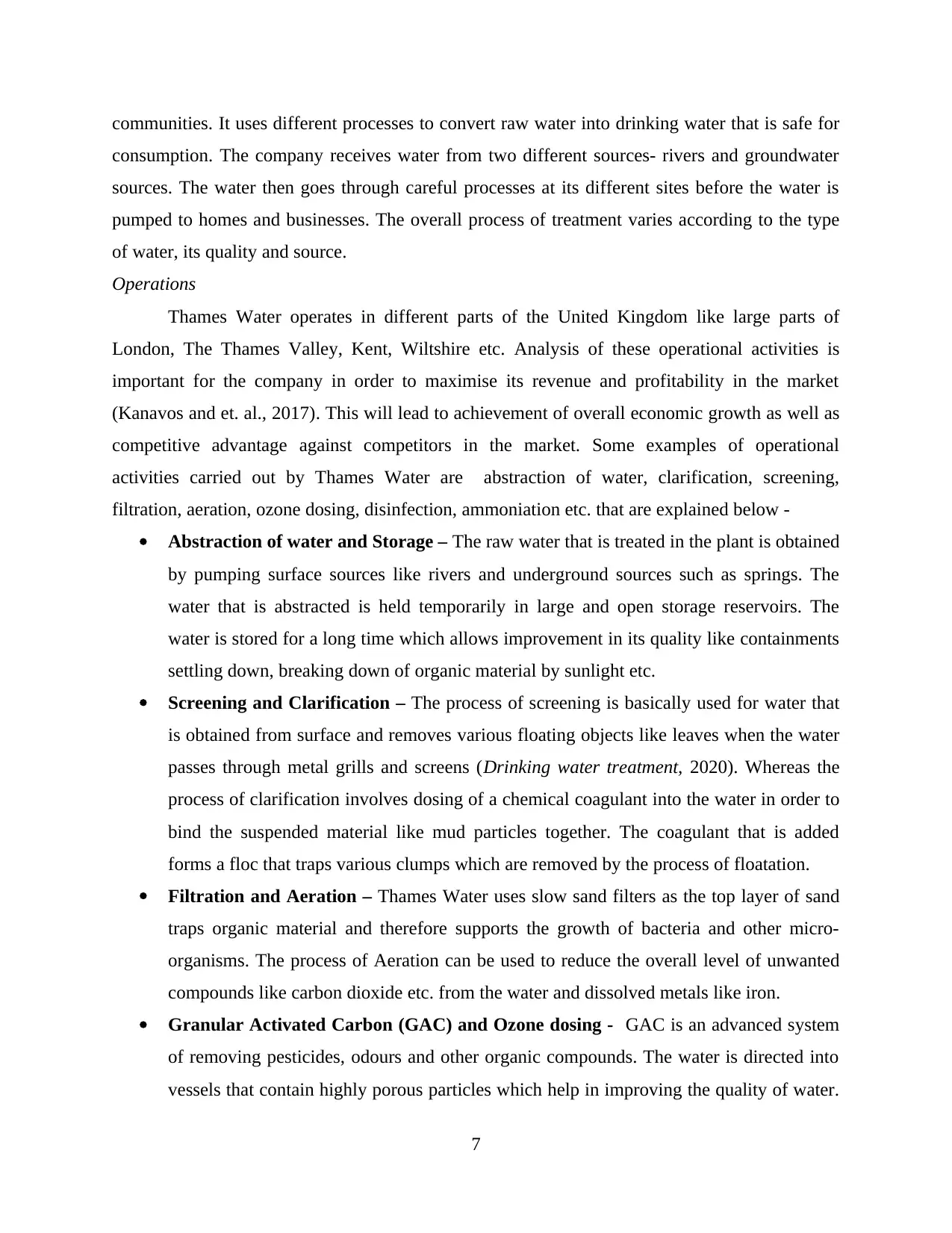
communities. It uses different processes to convert raw water into drinking water that is safe for
consumption. The company receives water from two different sources- rivers and groundwater
sources. The water then goes through careful processes at its different sites before the water is
pumped to homes and businesses. The overall process of treatment varies according to the type
of water, its quality and source.
Operations
Thames Water operates in different parts of the United Kingdom like large parts of
London, The Thames Valley, Kent, Wiltshire etc. Analysis of these operational activities is
important for the company in order to maximise its revenue and profitability in the market
(Kanavos and et. al., 2017). This will lead to achievement of overall economic growth as well as
competitive advantage against competitors in the market. Some examples of operational
activities carried out by Thames Water are abstraction of water, clarification, screening,
filtration, aeration, ozone dosing, disinfection, ammoniation etc. that are explained below -
Abstraction of water and Storage – The raw water that is treated in the plant is obtained
by pumping surface sources like rivers and underground sources such as springs. The
water that is abstracted is held temporarily in large and open storage reservoirs. The
water is stored for a long time which allows improvement in its quality like containments
settling down, breaking down of organic material by sunlight etc.
Screening and Clarification – The process of screening is basically used for water that
is obtained from surface and removes various floating objects like leaves when the water
passes through metal grills and screens (Drinking water treatment, 2020). Whereas the
process of clarification involves dosing of a chemical coagulant into the water in order to
bind the suspended material like mud particles together. The coagulant that is added
forms a floc that traps various clumps which are removed by the process of floatation.
Filtration and Aeration – Thames Water uses slow sand filters as the top layer of sand
traps organic material and therefore supports the growth of bacteria and other micro-
organisms. The process of Aeration can be used to reduce the overall level of unwanted
compounds like carbon dioxide etc. from the water and dissolved metals like iron.
Granular Activated Carbon (GAC) and Ozone dosing - GAC is an advanced system
of removing pesticides, odours and other organic compounds. The water is directed into
vessels that contain highly porous particles which help in improving the quality of water.
7
consumption. The company receives water from two different sources- rivers and groundwater
sources. The water then goes through careful processes at its different sites before the water is
pumped to homes and businesses. The overall process of treatment varies according to the type
of water, its quality and source.
Operations
Thames Water operates in different parts of the United Kingdom like large parts of
London, The Thames Valley, Kent, Wiltshire etc. Analysis of these operational activities is
important for the company in order to maximise its revenue and profitability in the market
(Kanavos and et. al., 2017). This will lead to achievement of overall economic growth as well as
competitive advantage against competitors in the market. Some examples of operational
activities carried out by Thames Water are abstraction of water, clarification, screening,
filtration, aeration, ozone dosing, disinfection, ammoniation etc. that are explained below -
Abstraction of water and Storage – The raw water that is treated in the plant is obtained
by pumping surface sources like rivers and underground sources such as springs. The
water that is abstracted is held temporarily in large and open storage reservoirs. The
water is stored for a long time which allows improvement in its quality like containments
settling down, breaking down of organic material by sunlight etc.
Screening and Clarification – The process of screening is basically used for water that
is obtained from surface and removes various floating objects like leaves when the water
passes through metal grills and screens (Drinking water treatment, 2020). Whereas the
process of clarification involves dosing of a chemical coagulant into the water in order to
bind the suspended material like mud particles together. The coagulant that is added
forms a floc that traps various clumps which are removed by the process of floatation.
Filtration and Aeration – Thames Water uses slow sand filters as the top layer of sand
traps organic material and therefore supports the growth of bacteria and other micro-
organisms. The process of Aeration can be used to reduce the overall level of unwanted
compounds like carbon dioxide etc. from the water and dissolved metals like iron.
Granular Activated Carbon (GAC) and Ozone dosing - GAC is an advanced system
of removing pesticides, odours and other organic compounds. The water is directed into
vessels that contain highly porous particles which help in improving the quality of water.
7
Paraphrase This Document
Need a fresh take? Get an instant paraphrase of this document with our AI Paraphraser
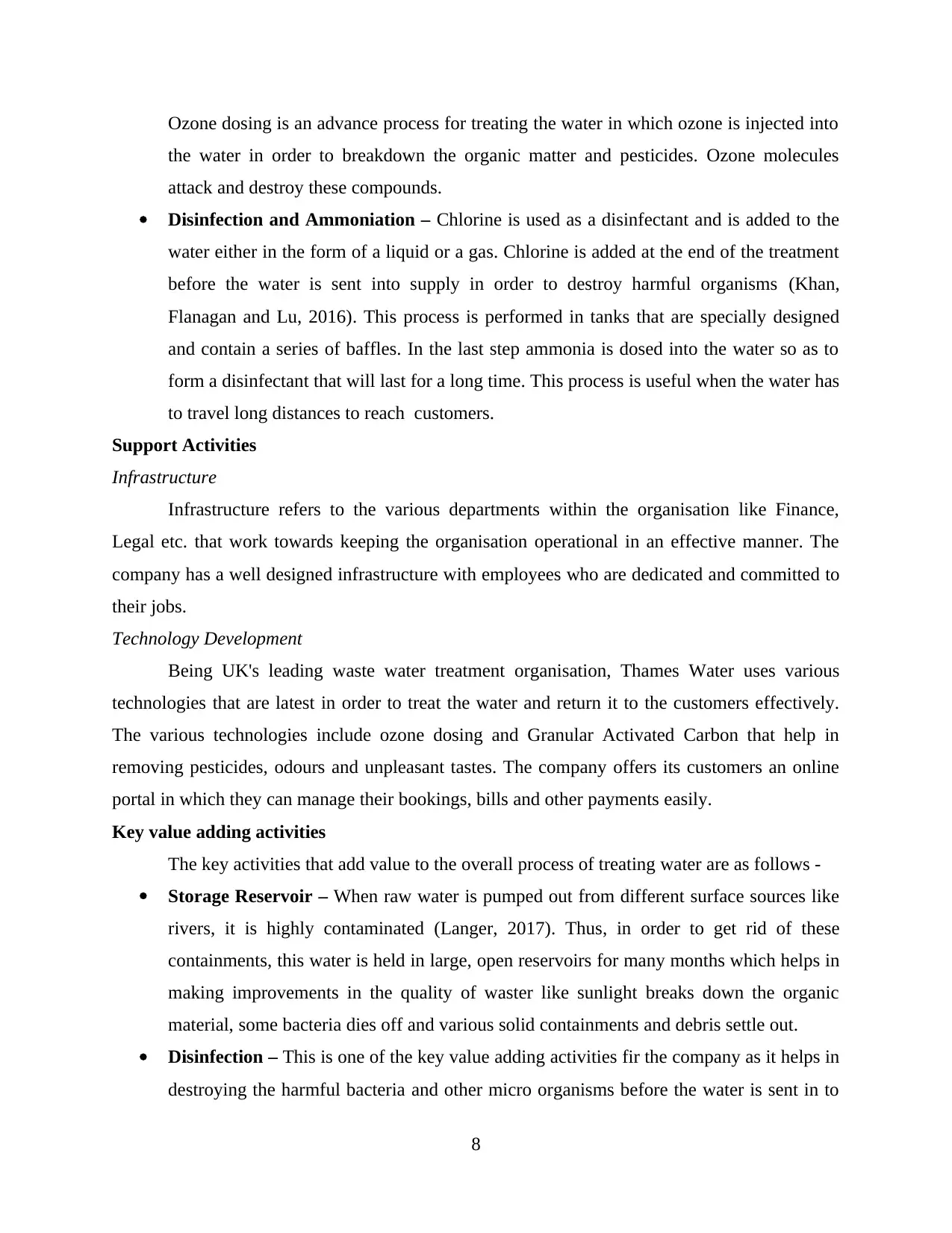
Ozone dosing is an advance process for treating the water in which ozone is injected into
the water in order to breakdown the organic matter and pesticides. Ozone molecules
attack and destroy these compounds.
Disinfection and Ammoniation – Chlorine is used as a disinfectant and is added to the
water either in the form of a liquid or a gas. Chlorine is added at the end of the treatment
before the water is sent into supply in order to destroy harmful organisms (Khan,
Flanagan and Lu, 2016). This process is performed in tanks that are specially designed
and contain a series of baffles. In the last step ammonia is dosed into the water so as to
form a disinfectant that will last for a long time. This process is useful when the water has
to travel long distances to reach customers.
Support Activities
Infrastructure
Infrastructure refers to the various departments within the organisation like Finance,
Legal etc. that work towards keeping the organisation operational in an effective manner. The
company has a well designed infrastructure with employees who are dedicated and committed to
their jobs.
Technology Development
Being UK's leading waste water treatment organisation, Thames Water uses various
technologies that are latest in order to treat the water and return it to the customers effectively.
The various technologies include ozone dosing and Granular Activated Carbon that help in
removing pesticides, odours and unpleasant tastes. The company offers its customers an online
portal in which they can manage their bookings, bills and other payments easily.
Key value adding activities
The key activities that add value to the overall process of treating water are as follows -
Storage Reservoir – When raw water is pumped out from different surface sources like
rivers, it is highly contaminated (Langer, 2017). Thus, in order to get rid of these
containments, this water is held in large, open reservoirs for many months which helps in
making improvements in the quality of waster like sunlight breaks down the organic
material, some bacteria dies off and various solid containments and debris settle out.
Disinfection – This is one of the key value adding activities fir the company as it helps in
destroying the harmful bacteria and other micro organisms before the water is sent in to
8
the water in order to breakdown the organic matter and pesticides. Ozone molecules
attack and destroy these compounds.
Disinfection and Ammoniation – Chlorine is used as a disinfectant and is added to the
water either in the form of a liquid or a gas. Chlorine is added at the end of the treatment
before the water is sent into supply in order to destroy harmful organisms (Khan,
Flanagan and Lu, 2016). This process is performed in tanks that are specially designed
and contain a series of baffles. In the last step ammonia is dosed into the water so as to
form a disinfectant that will last for a long time. This process is useful when the water has
to travel long distances to reach customers.
Support Activities
Infrastructure
Infrastructure refers to the various departments within the organisation like Finance,
Legal etc. that work towards keeping the organisation operational in an effective manner. The
company has a well designed infrastructure with employees who are dedicated and committed to
their jobs.
Technology Development
Being UK's leading waste water treatment organisation, Thames Water uses various
technologies that are latest in order to treat the water and return it to the customers effectively.
The various technologies include ozone dosing and Granular Activated Carbon that help in
removing pesticides, odours and unpleasant tastes. The company offers its customers an online
portal in which they can manage their bookings, bills and other payments easily.
Key value adding activities
The key activities that add value to the overall process of treating water are as follows -
Storage Reservoir – When raw water is pumped out from different surface sources like
rivers, it is highly contaminated (Langer, 2017). Thus, in order to get rid of these
containments, this water is held in large, open reservoirs for many months which helps in
making improvements in the quality of waster like sunlight breaks down the organic
material, some bacteria dies off and various solid containments and debris settle out.
Disinfection – This is one of the key value adding activities fir the company as it helps in
destroying the harmful bacteria and other micro organisms before the water is sent in to
8
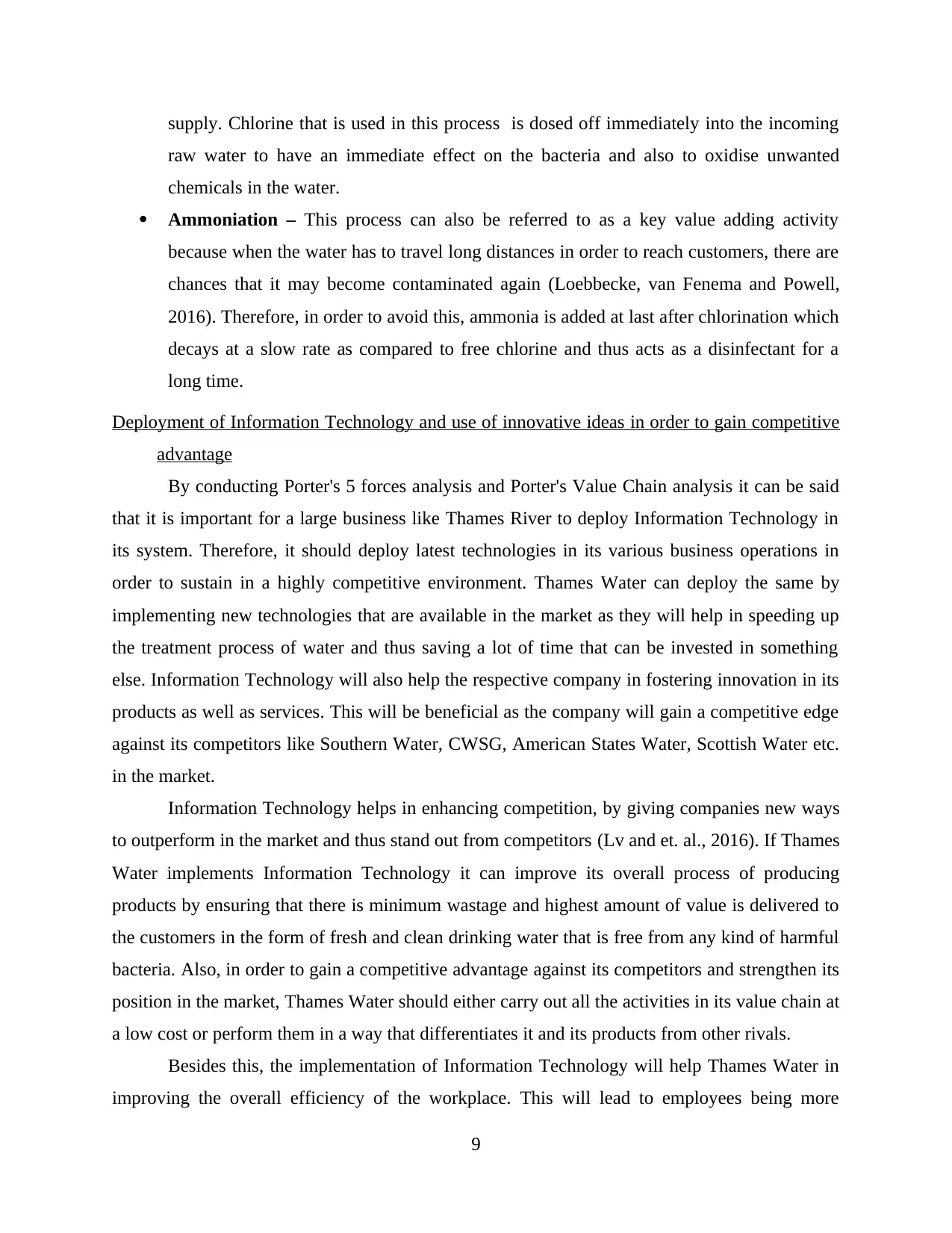
supply. Chlorine that is used in this process is dosed off immediately into the incoming
raw water to have an immediate effect on the bacteria and also to oxidise unwanted
chemicals in the water.
Ammoniation – This process can also be referred to as a key value adding activity
because when the water has to travel long distances in order to reach customers, there are
chances that it may become contaminated again (Loebbecke, van Fenema and Powell,
2016). Therefore, in order to avoid this, ammonia is added at last after chlorination which
decays at a slow rate as compared to free chlorine and thus acts as a disinfectant for a
long time.
Deployment of Information Technology and use of innovative ideas in order to gain competitive
advantage
By conducting Porter's 5 forces analysis and Porter's Value Chain analysis it can be said
that it is important for a large business like Thames River to deploy Information Technology in
its system. Therefore, it should deploy latest technologies in its various business operations in
order to sustain in a highly competitive environment. Thames Water can deploy the same by
implementing new technologies that are available in the market as they will help in speeding up
the treatment process of water and thus saving a lot of time that can be invested in something
else. Information Technology will also help the respective company in fostering innovation in its
products as well as services. This will be beneficial as the company will gain a competitive edge
against its competitors like Southern Water, CWSG, American States Water, Scottish Water etc.
in the market.
Information Technology helps in enhancing competition, by giving companies new ways
to outperform in the market and thus stand out from competitors (Lv and et. al., 2016). If Thames
Water implements Information Technology it can improve its overall process of producing
products by ensuring that there is minimum wastage and highest amount of value is delivered to
the customers in the form of fresh and clean drinking water that is free from any kind of harmful
bacteria. Also, in order to gain a competitive advantage against its competitors and strengthen its
position in the market, Thames Water should either carry out all the activities in its value chain at
a low cost or perform them in a way that differentiates it and its products from other rivals.
Besides this, the implementation of Information Technology will help Thames Water in
improving the overall efficiency of the workplace. This will lead to employees being more
9
raw water to have an immediate effect on the bacteria and also to oxidise unwanted
chemicals in the water.
Ammoniation – This process can also be referred to as a key value adding activity
because when the water has to travel long distances in order to reach customers, there are
chances that it may become contaminated again (Loebbecke, van Fenema and Powell,
2016). Therefore, in order to avoid this, ammonia is added at last after chlorination which
decays at a slow rate as compared to free chlorine and thus acts as a disinfectant for a
long time.
Deployment of Information Technology and use of innovative ideas in order to gain competitive
advantage
By conducting Porter's 5 forces analysis and Porter's Value Chain analysis it can be said
that it is important for a large business like Thames River to deploy Information Technology in
its system. Therefore, it should deploy latest technologies in its various business operations in
order to sustain in a highly competitive environment. Thames Water can deploy the same by
implementing new technologies that are available in the market as they will help in speeding up
the treatment process of water and thus saving a lot of time that can be invested in something
else. Information Technology will also help the respective company in fostering innovation in its
products as well as services. This will be beneficial as the company will gain a competitive edge
against its competitors like Southern Water, CWSG, American States Water, Scottish Water etc.
in the market.
Information Technology helps in enhancing competition, by giving companies new ways
to outperform in the market and thus stand out from competitors (Lv and et. al., 2016). If Thames
Water implements Information Technology it can improve its overall process of producing
products by ensuring that there is minimum wastage and highest amount of value is delivered to
the customers in the form of fresh and clean drinking water that is free from any kind of harmful
bacteria. Also, in order to gain a competitive advantage against its competitors and strengthen its
position in the market, Thames Water should either carry out all the activities in its value chain at
a low cost or perform them in a way that differentiates it and its products from other rivals.
Besides this, the implementation of Information Technology will help Thames Water in
improving the overall efficiency of the workplace. This will lead to employees being more
9
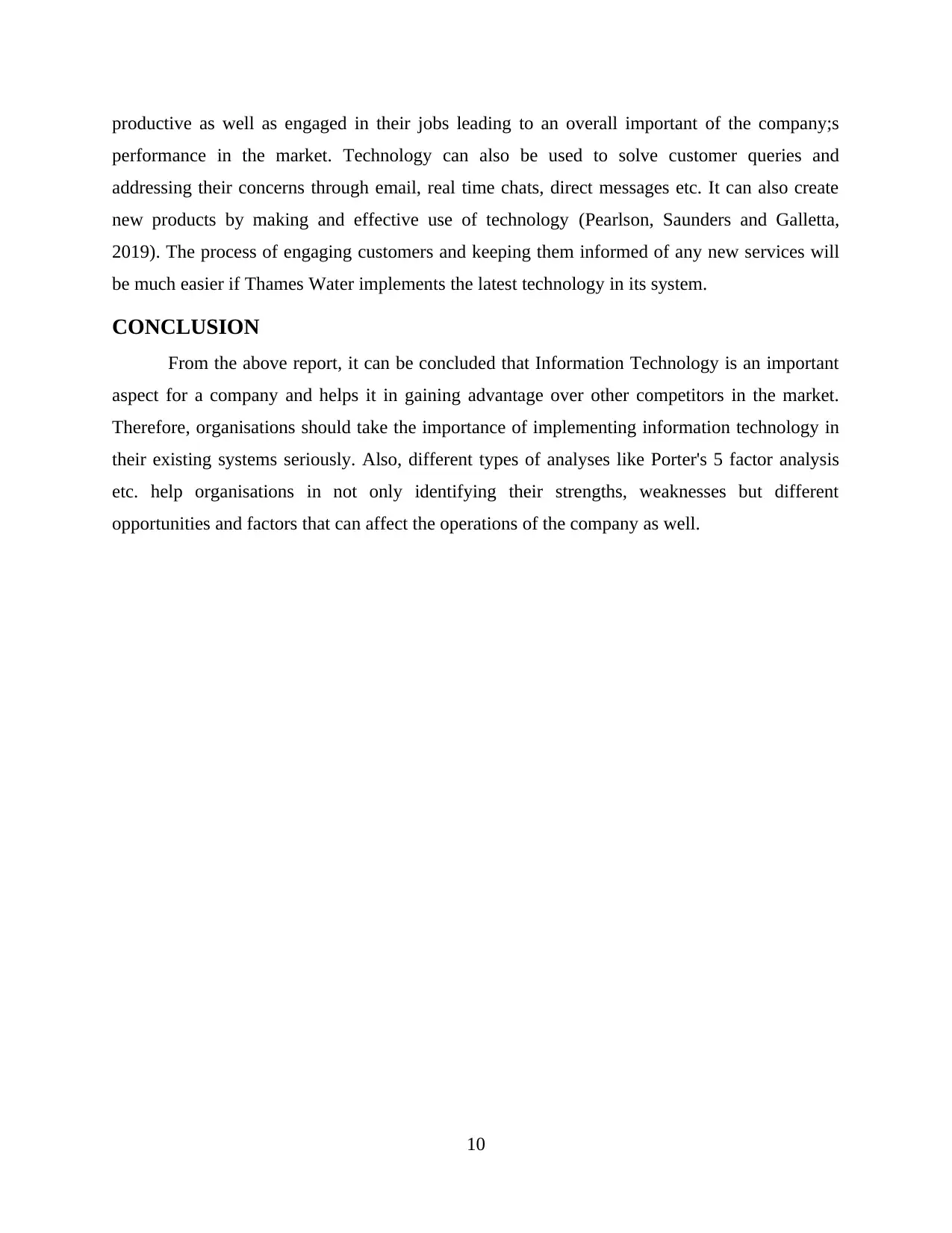
productive as well as engaged in their jobs leading to an overall important of the company;s
performance in the market. Technology can also be used to solve customer queries and
addressing their concerns through email, real time chats, direct messages etc. It can also create
new products by making and effective use of technology (Pearlson, Saunders and Galletta,
2019). The process of engaging customers and keeping them informed of any new services will
be much easier if Thames Water implements the latest technology in its system.
CONCLUSION
From the above report, it can be concluded that Information Technology is an important
aspect for a company and helps it in gaining advantage over other competitors in the market.
Therefore, organisations should take the importance of implementing information technology in
their existing systems seriously. Also, different types of analyses like Porter's 5 factor analysis
etc. help organisations in not only identifying their strengths, weaknesses but different
opportunities and factors that can affect the operations of the company as well.
10
performance in the market. Technology can also be used to solve customer queries and
addressing their concerns through email, real time chats, direct messages etc. It can also create
new products by making and effective use of technology (Pearlson, Saunders and Galletta,
2019). The process of engaging customers and keeping them informed of any new services will
be much easier if Thames Water implements the latest technology in its system.
CONCLUSION
From the above report, it can be concluded that Information Technology is an important
aspect for a company and helps it in gaining advantage over other competitors in the market.
Therefore, organisations should take the importance of implementing information technology in
their existing systems seriously. Also, different types of analyses like Porter's 5 factor analysis
etc. help organisations in not only identifying their strengths, weaknesses but different
opportunities and factors that can affect the operations of the company as well.
10
Secure Best Marks with AI Grader
Need help grading? Try our AI Grader for instant feedback on your assignments.
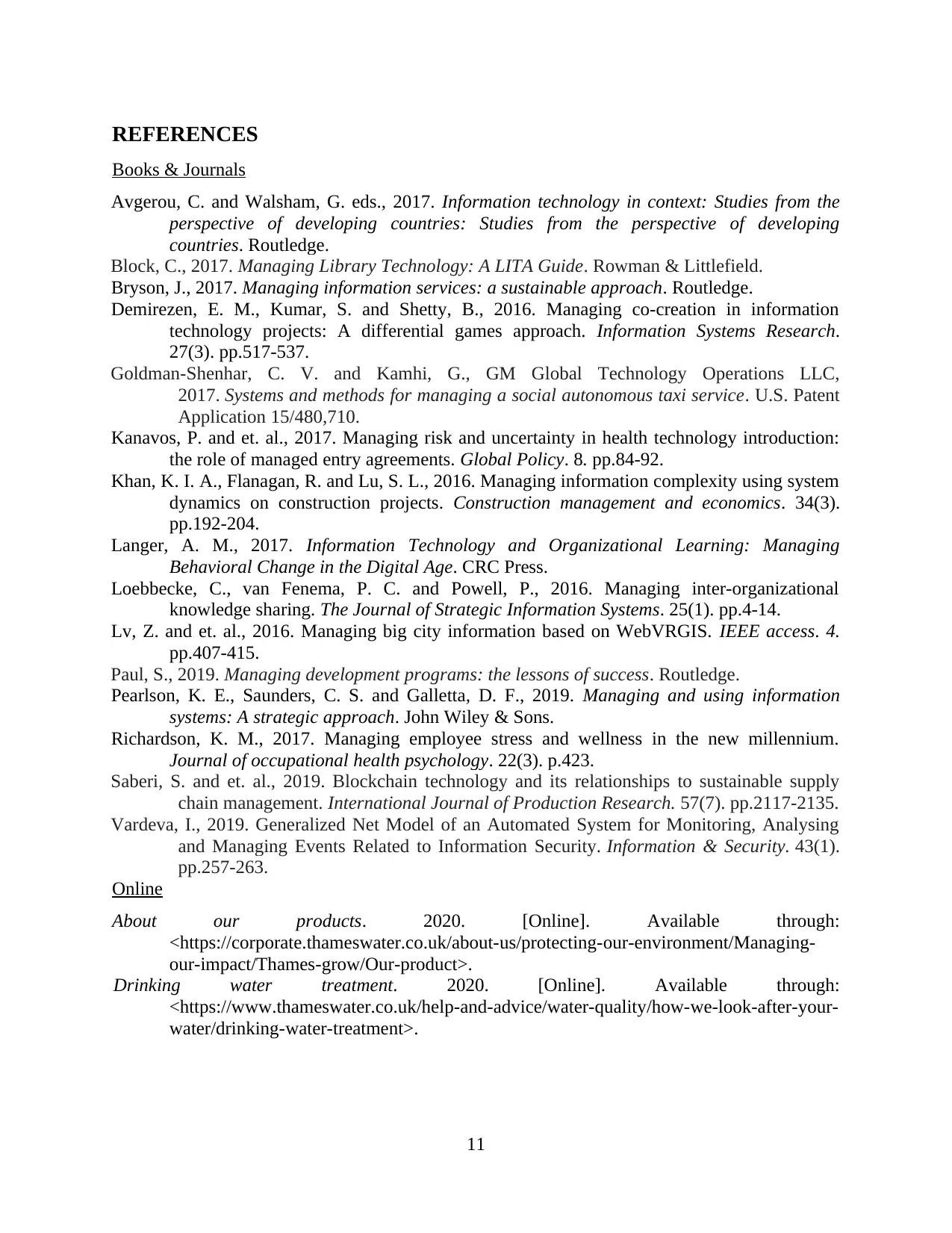
REFERENCES
Books & Journals
Avgerou, C. and Walsham, G. eds., 2017. Information technology in context: Studies from the
perspective of developing countries: Studies from the perspective of developing
countries. Routledge.
Block, C., 2017. Managing Library Technology: A LITA Guide. Rowman & Littlefield.
Bryson, J., 2017. Managing information services: a sustainable approach. Routledge.
Demirezen, E. M., Kumar, S. and Shetty, B., 2016. Managing co-creation in information
technology projects: A differential games approach. Information Systems Research.
27(3). pp.517-537.
Goldman-Shenhar, C. V. and Kamhi, G., GM Global Technology Operations LLC,
2017. Systems and methods for managing a social autonomous taxi service. U.S. Patent
Application 15/480,710.
Kanavos, P. and et. al., 2017. Managing risk and uncertainty in health technology introduction:
the role of managed entry agreements. Global Policy. 8. pp.84-92.
Khan, K. I. A., Flanagan, R. and Lu, S. L., 2016. Managing information complexity using system
dynamics on construction projects. Construction management and economics. 34(3).
pp.192-204.
Langer, A. M., 2017. Information Technology and Organizational Learning: Managing
Behavioral Change in the Digital Age. CRC Press.
Loebbecke, C., van Fenema, P. C. and Powell, P., 2016. Managing inter-organizational
knowledge sharing. The Journal of Strategic Information Systems. 25(1). pp.4-14.
Lv, Z. and et. al., 2016. Managing big city information based on WebVRGIS. IEEE access. 4.
pp.407-415.
Paul, S., 2019. Managing development programs: the lessons of success. Routledge.
Pearlson, K. E., Saunders, C. S. and Galletta, D. F., 2019. Managing and using information
systems: A strategic approach. John Wiley & Sons.
Richardson, K. M., 2017. Managing employee stress and wellness in the new millennium.
Journal of occupational health psychology. 22(3). p.423.
Saberi, S. and et. al., 2019. Blockchain technology and its relationships to sustainable supply
chain management. International Journal of Production Research. 57(7). pp.2117-2135.
Vardeva, I., 2019. Generalized Net Model of an Automated System for Monitoring, Analysing
and Managing Events Related to Information Security. Information & Security. 43(1).
pp.257-263.
Online
About our products. 2020. [Online]. Available through:
<https://corporate.thameswater.co.uk/about-us/protecting-our-environment/Managing-
our-impact/Thames-grow/Our-product>.
Drinking water treatment. 2020. [Online]. Available through:
<https://www.thameswater.co.uk/help-and-advice/water-quality/how-we-look-after-your-
water/drinking-water-treatment>.
11
Books & Journals
Avgerou, C. and Walsham, G. eds., 2017. Information technology in context: Studies from the
perspective of developing countries: Studies from the perspective of developing
countries. Routledge.
Block, C., 2017. Managing Library Technology: A LITA Guide. Rowman & Littlefield.
Bryson, J., 2017. Managing information services: a sustainable approach. Routledge.
Demirezen, E. M., Kumar, S. and Shetty, B., 2016. Managing co-creation in information
technology projects: A differential games approach. Information Systems Research.
27(3). pp.517-537.
Goldman-Shenhar, C. V. and Kamhi, G., GM Global Technology Operations LLC,
2017. Systems and methods for managing a social autonomous taxi service. U.S. Patent
Application 15/480,710.
Kanavos, P. and et. al., 2017. Managing risk and uncertainty in health technology introduction:
the role of managed entry agreements. Global Policy. 8. pp.84-92.
Khan, K. I. A., Flanagan, R. and Lu, S. L., 2016. Managing information complexity using system
dynamics on construction projects. Construction management and economics. 34(3).
pp.192-204.
Langer, A. M., 2017. Information Technology and Organizational Learning: Managing
Behavioral Change in the Digital Age. CRC Press.
Loebbecke, C., van Fenema, P. C. and Powell, P., 2016. Managing inter-organizational
knowledge sharing. The Journal of Strategic Information Systems. 25(1). pp.4-14.
Lv, Z. and et. al., 2016. Managing big city information based on WebVRGIS. IEEE access. 4.
pp.407-415.
Paul, S., 2019. Managing development programs: the lessons of success. Routledge.
Pearlson, K. E., Saunders, C. S. and Galletta, D. F., 2019. Managing and using information
systems: A strategic approach. John Wiley & Sons.
Richardson, K. M., 2017. Managing employee stress and wellness in the new millennium.
Journal of occupational health psychology. 22(3). p.423.
Saberi, S. and et. al., 2019. Blockchain technology and its relationships to sustainable supply
chain management. International Journal of Production Research. 57(7). pp.2117-2135.
Vardeva, I., 2019. Generalized Net Model of an Automated System for Monitoring, Analysing
and Managing Events Related to Information Security. Information & Security. 43(1).
pp.257-263.
Online
About our products. 2020. [Online]. Available through:
<https://corporate.thameswater.co.uk/about-us/protecting-our-environment/Managing-
our-impact/Thames-grow/Our-product>.
Drinking water treatment. 2020. [Online]. Available through:
<https://www.thameswater.co.uk/help-and-advice/water-quality/how-we-look-after-your-
water/drinking-water-treatment>.
11
1 out of 11
Your All-in-One AI-Powered Toolkit for Academic Success.
+13062052269
info@desklib.com
Available 24*7 on WhatsApp / Email
![[object Object]](/_next/static/media/star-bottom.7253800d.svg)
Unlock your academic potential
© 2024 | Zucol Services PVT LTD | All rights reserved.
